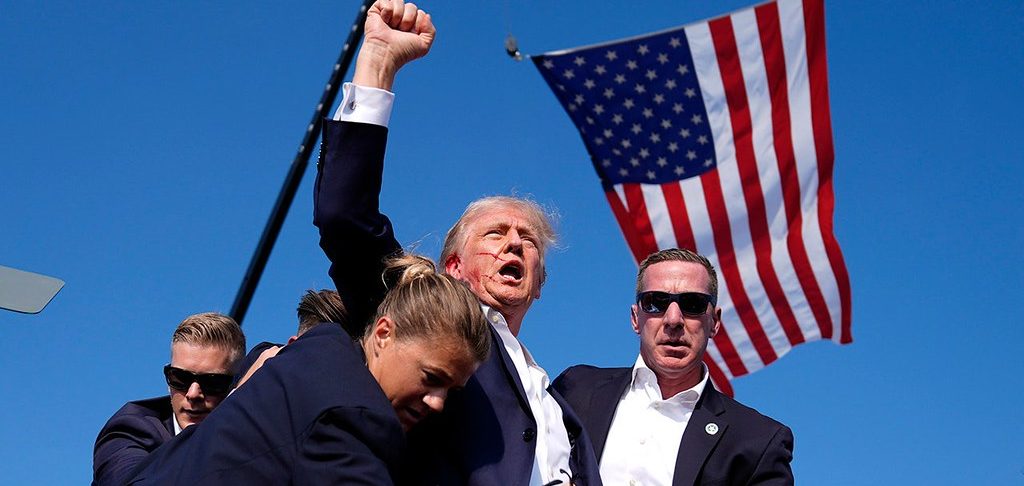From assassination attempts to bacon sandwiches: How photography affects politics
The assassination attempt on controversial presidential candidate Donald Trump was another watershed moment in the ongoing drama of the 2024 US Election, with the startling act of political violence occurring at a campaign rally near Butler, Pennsylvania. The assassin’s bullets grazed the ear of President Trump and killed Corey Comperatore. In the confusion, the Secret Service, as is their training, huddled upon Trump in order to avoid any further harm. Trump broke protocol, stuck his head out of the escort, and pumped his fist into the air in front of the American flag, shouting “fight,” creating what is one of the most instantly iconic photographs of the Trump campaign, as captured by Pulitzer Prize winner Evan Vucci of the Associated Press.
Politically, photography is one of the most useful tools that can win an election with its ability to convey the cliched one thousand words.
Vucci’s photo was soon adopted by the people. Within the hour, photos and videos of the event were being reported by news sources and social media alike, attracting clamour from his supporters with the triumphant photo showing their leader projecting near-messianic strength in a time of great turmoil. Politically, photography is one of the most useful tools that can win an election with its ability to convey the cliched one thousand words. Trump’s fanbase repeatedly shared the photo over their respective social media platforms, and it doesn’t take an artistic knowledge to see its success on a purely compositional basis. The American flag waving against the blue sky, the mass of dark suits with darker sunglasses and Trump’s recognisable face being just below it, streaming with blood, relating the presidential candidate and the flag. It is an inherently victorious sight. Jonathan Jones of The Guardian compared it to Raising the Flag on Iwo Jima by Joe Rosenthal, another picture-perfect show of patriotic Americana. The effect clearly is in Trump’s political favour, with the Republican party’s ability to show their leader as one who can beat even a gunshot from a rogue assassin. It fits nicely into the canon of assassination recollection. The Zapruder film is the definitive end to Camelot, and to American optimism of the media age. Lincoln’s assassination, whilst not caught on camera, has been depicted with more creative control in the form of paintings, showing a martyr dying for his country with effective dramatic blocking. There are few things better for one’s legacy than an untimely death.
The camera’s eye is more crafty than it is assumed to be and can be easily manipulated to drive the same ideological battles that other political tools can.
The role of media in politics constantly comes against criticism from all angles. Most worry about the bias of their personally hated outlet, such as Fox News’ Republican leaning, retorted usually by CNN Democrat bias. Across the Atlantic, The Guardian’s Liberal Left outlook, and the populist right wing leaning of incredibly popular tabloid papers. More importantly, in later years, is the presence of social media and the echo chambers that can come about as a result. For example, the mugshot of Donald Trump was instantaneously a landmark photograph. It was the first time the public had ever seen a president be convicted of a felony, and so publically close to his election. You would think that by showing a candidate in disgrace it would deter support, but the inverse reaction took place with the photo being spread around social media and then shrewdly adopted by the Trump campaign, allowing them to convey their candidate as a man who is being persecuted by the powers that be and how he, even at that position of vulnerability, stands and scowls at the camera, looking like Dirty Harry if he worked in real estate. He is not gonna take it, even if they have him on all of those felonies.
The camera’s eye is more crafty than it is assumed to be and can be easily manipulated to drive the same ideological battles that other political tools can. Ed Miliband’s famous Bacon Sandwich photograph was snapped up by The London Evening Standard in order to question Miliband’s ability to run a country and his ability to eat a sandwich. The problem here lies in the fact that everyone has their moments of aesthetic vulnerability, yet few of us have the unfortunate problem of people capturing us at our least photogenic. That is one of the most important aspects of a photograph; it captures a single moment and immortalises it.
Trump’s Assassination photos will be the study of political analysts and media experts alike, perhaps revealing the power that the event and its reporting had in swaying America’s future.
Every time someone sees a photograph, the moment is replayed again. It avoids the entropy and interpretation of the video format for the easier-to-perfect photograph. For every photo of Miliband looking ministerial or Trump seeming corrupt, the public ignored it for their much more striking counterparts. That’s how they get you. That’s how the PR and the spin doctors want you to see things regardless of viewpoint. The modern political landscape serves notes of truth in chords of carefully articulated viewpoints.
As the campaign continues into its later stages and America prepares for a change in administration, Trump’s Assassination photos will be the study of political analysts and media experts alike, perhaps revealing the power that the event and its reporting had in swaying America’s future.

Comments